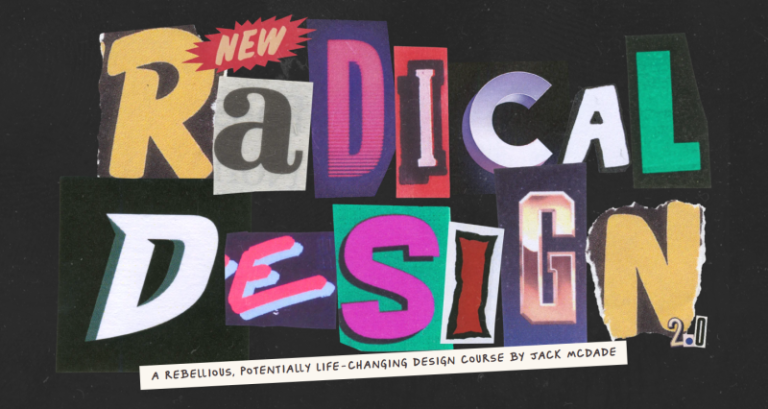Radical Design – McDade Jackson
$249.00 Original price was: $249.00.$24.90Current price is: $24.90.
- Delivery: You Will Receive A Receipt With Download Link Through Email.
- If you need more proof ofcourse, feel free to chat with me!

Sales Page: https://radicaldesigncourse.com/
Delivery Time: Instant DownloadDescription
Table of Contents
ToggleProof of payment:


Unleash Your Inner Maverick – A Deep Dive Into Radical Design. This article explores the transformative approach to design known as Radical Design, as championed by Jack McDade, diving into its core principles, rebellious spirit, and the unique learning experience it offers.
Radical Design
At its core, Radical Design, as conceived by Jack McDade, is a movement away from the mundane and a bold leap towards originality. It’s a philosophy that challenges the status quo of template-driven design and encourages designers to cultivate their unique voices. It’s not just a style; it’s a mindset that values creativity, authenticity, and a user-centric approach. It’s about more than just making things look pretty; it’s about creating meaningful experiences that resonate with both the designer and the end-user. The essence of this approach lies in its deliberate rebellion against the predictable, the derivative, and the bland. It urges designers to explore uncharted territories of their creativity, moving beyond the well-trodden paths of conventional design wisdom. This course is an invitation to embrace the unconventional, to get “weird”, and to discover the power of a design style that is truly your own.
The Anathema of Boring Design
In the realm of web design, a monotonous symphony of sameness often plays out, each website echoing the last with minor variations on a well-worn theme. This is the very thing that Radical Design seeks to dismantle. Jack McDade’s perspective is that the web has become too predictable, riddled with fill-in-the-blank websites that lack personality. This perspective resonates with many designers who yearn for work that’s more imaginative and impactful. It identifies the core problem as not being about lack of skill but rather a lack of courage to deviate from established norms. The course explicitly positions itself as an antidote, promising a refuge in creative expression. It’s a call to action for designers looking to break free from the shackles of uninspired design and embrace a path of fearless innovation.
McDade’s approach is quite direct. He challenges the ubiquitous templates and pre-designed layouts that dominate web design today. This is not about discarding templates entirely, but more about understanding that relying too heavily on them can stagnate creativity. The goal is not just to make something visually pleasing but also to leave a mark, something memorable. It involves a shift from merely filling space with content towards creating experiences that engage and resonate on a deeper level. It’s about shifting the design mindset from passive execution to inspired creation, resulting in digital presence that commands attention. It’s about recognizing that the canvas of digital design is vast, and the opportunities for creative expression are limitless, if one dares to explore.
Cultivating a Distinctive Style
One of the most compelling promises of this approach is that it’s focused on crafting your unique style. The course does not offer a shortcut to emulating McDade’s success. Instead, it presents a path to self-discovery through design. This is where the radical part of the approach comes in. Rather than mimicking popular trends or established styles, students are encouraged to delve deep into their own creativity. This principle is essential for anyone looking to distinguish themselves, to be seen rather than be another face in the crowd. In essence the course is designed to be less of a how-to and more of a how-to-be-you guide.
The emphasis on self-discovery highlights a critical aspect often overlooked in traditional design education. Often designers are taught to adhere to existing styles and replicate established successful designs. Yet, this method stifles originality. The course challenges designers to recognize their unique voice and to amplify it. This isn’t just about surface aesthetics, it’s about understanding that personal expression is the true foundation of compelling design. That’s different from simply adhering to the latest trends. The core idea isn’t just about being different for the sake of difference, it’s about creating designs that are authentic, memorable and that resonate with personal style. It’s about a transition from imitating to innovating, something that is transformative for designers at all phases of their career.
Originality and the Creative Dive
A cornerstone of Radical Design is the encouragement of raw creativity and unconventional methodologies . This philosophy isn’t about playing it safe, but about fearlessly breaking the mold. It is about embracing the strange, exploring the unexpected, and venturing into the uncharted territories of your design process. There’s a call for designers to get “weird”, which, in this context, translates to thinking beyond established boundaries and pushing the limits of what is considered the norm. The aim is to shake free of the constraints of conventional design thinking and embrace the unexpected and unconventional. It’s about finding the extraordinary in the ordinary, about challenging design habits and processes.
McDade champions the idea that innovation often emerges from diverging from the norm. He states that “I’ve made a living zigging when everyone else zags,” clearly showing the power of originality. This isn’t about being different simply for the sake of being different. It is about finding creative solutions that resonate more deeply because they are born of authentic vision and a willingness to challenge established practices. The approach is about embracing the unfamiliar and taking unconventional paths as a potent way to develop unique solutions that truly resonate. The approach fosters an environment where experimentation and deviation from the norm aren’t just permitted but are actively encouraged.
McDade Jackson
The name McDade Jackson is synonymous with a fiercely independent design philosophy. Jack McDade’s approach to design stems from his experience as a creator rather than a pure theorist. He has built his career on breaking traditional boundaries and it’s worth looking at his approach to Radical Design as a reflection of his own journey. His focus on the individual’s unique expression, which is mirrored in his work and online presence, demonstrates a deep understanding that authenticity is paramount in design and in life. He isn’t just teaching a methodology, he’s sharing a part of himself. He comes across as a mentor who inspires designers to embark on their own journeys in finding their unique style. This is not a cookie-cutter approach; it is a way of thinking and self-expression.
McDade is a designer, developer, and entrepreneur, and his background provides the foundation for the course’s teachings that go beyond just theory. He’s not just talking about thinking different, He has actually built a career doing it. His emphasis on the practical aspects of design, combined with the encouragement of unconventional thinking, underscores a holistic approach to design. It reflects the experience of someone who has worked to build their brand, not someone who learned design in a classroom setting. This hands-on perspective provides designers the tools and insight necessary to build their own unique styles. It’s a practical, hands-on approach that speaks directly to the real-world challenges and opportunities of creative thinking and the world of design.
The User-Centric Paradox
A common assumption might be that an embrace of bold, radical style might somehow negate the importance of the user’s needs. McDade Jackson’s approach, however, deftly navigates this paradox. He argues that being experimental and prioritising user experience is not mutually exclusive. What comes out is that in order to make designs memorable and impactful it’s essential that they also be functional and user-friendly. This balanced approach reflects an understanding that design is not just about aesthetics but also about solving real problems for real people. It’s the fusion of personal expression with practical user-focused thinking.
The user is not just seen as a target audience. The user’s needs and experiences are a compass for the designer. His emphasis isn’t just about creating visually striking work, but also about understanding the end-user. He recognizes that the most impactful designs are also the ones that resonate at a personal level and can satisfy the end users needs. So, instead of design that lacks a user focus in favor of only aesthetics, there must be both. The essence of this is realizing that a user-centric approach is not a hindrance to creativity but a guide to create work that is simultaneously engaging and effective. It’s a way of designing for impact, not just for personal expression.
Content as the Crucible of Design
McDade’s philosophy is very clear here – great design cannot exist in isolation; it needs meaningful content. This foundational concept shows the importance of a clear message and a strong narrative. This is not about design first, content later; it’s about a symbiotic relationship where content shapes design. The emphasis on having that content first is a crucial perspective that often gets overlooked in the fast-paced world of design. It adds that before the first line of code is written, or a design tool is even opened, the story to be told is already there. It’s a reminder that design serves a purpose beyond visual appeal; it’s about conveying information, inspiring emotion, and creating connection.
McDade’s viewpoint is that good content is the bedrock upon which all great design is built. This is a very direct and clear point. In short, without a good message, the design is at risk of being without direction, no matter how well done it is. The quality of your content directly influences the impact of your design. This approach forces designers to be more intentional and think about the message they want to convey before the designing process is started. In short, the most significant designs are always the ones that spring from the richest content, creating a powerful connection between message and purpose.
Practical Application and Tools in the Radical World
McDade’s Radical Design isn’t just a theoretical approach; it’s a practical method focused on real-world application. The course’s emphasis on hands-on learning is quite clear and comes across as a crucial component of its design. The daily prompts, project-focused lessons, and an access to a comprehensive resource library, ensures that learning is a seamless integration of theory and practice. This is not about abstract concepts. The approach is centered on making an immediate impact through practical implementation and real-world project application. The goal is to take learned concepts and translate them directly into practical skills and tangible outcomes.
The course does not shy away from conventional design tools. Rather, it shows how these tools can be used in unconventional ways, pushing beyond the limitations of the expected. The incorporation of Sketch, Photoshop, Illustrator, and other similar tools into the syllabus further underscores the course’s dedication to practical application and development of marketable skills. It is not about abandoning the familiar but rather pushing the designer to find new ways to implement existing tools. The goal is not to simply learn how to use software, but, how to wield it with intention and innovation in order to bring design visions to life. It’s a fusion of practical skills with revolutionary creative thinking.
Rebellious design.
Rebellious design, as it’s explored through the lens of Jack McDade’s work, is more than just a term; it is an attitude. It’s a purposeful rejection of derivative work and an embrace of individuality. It signals a move away from the safety of the familiar and dares designers to venture into the unusual and uncharted territories of their creativity. It’s not about being contrarian for the sake of it; it is about forging a path that is unique, memorable, and reflective of one’s own authentic style. It’s a call to arms against the dull and predictable, where the goal isn’t to merely exist but to truly stand out. This approach is about challenging norms and using that as the basis for creating work that is distinct and full of personal style.
Rebellious Design, in this context, also signifies a deep respect for the principles of good design. It’s about not abandoning the foundations of design but rather using them as a solid basis from where to spring into new creative endeavors. One isn’t dismissing the conventional but rather transforming the approach, applying time-tested principles into a new and original style. The course doesn’t advocate for chaos or reckless abandon; rather, it advocates for thoughtfully pushing the boundaries, using intention and understanding of the core design concepts to reach new heights. It’s about a creative resistance towards being generic and a wholehearted embracing of individualistic expression. This is a movement not against the rules but towards setting your own.
The Radical Learning Experience.
The course’s structure is designed to be a self-guided “Choose Your Own Adventure,” offering a diverse array of resources to cater to various learning styles and paces. This non-linear approach allows students to learn based on their preferences, selecting from a library of videos, articles, and resources. This method contrasts with the rigid curricula of most design courses. It is not about adhering to a single structured path, but exploring the creative territories that best suits the student and their current development. This emphasis on self-navigation underscores a fundamental principle – the journey of design is always a personal one. It encourages students to take ownership of their learning and to shape that learning according to individual needs and interests.
The flexibility built into the course has a bigger purpose. It enables designers to not just learn but to actively engage and create a course that is tailored to their personal learning style. This isn’t just about consuming content; it’s about participating in a learning experience curated by the individual student. The course recognizes that not all designers learn the same way, and that providing options is key to creating a robust and effective learning environment. This flexible approach allows each designer to develop their skills at their own pace. They are provided with the tools to learn in a manner that is most effective. This results in a unique and rewarding learning journey that goes well beyond the ordinary.
Breaking Free From the Template Trap
The course’s rejection of fill-in-the-blank templates is very clear. This is a rejection of the norm where design has become a paint-by-numbers exercise, with results that are predictable and often indistinguishable. This isn’t to say that all templates are inherently bad; it’s more about challenging the over-reliance of them. The over-reliance on templates has become a crutch in the creative design process. This leads to the widespread problem of uninspiring design work. Often, instead of inspiring innovation, templates encourage a copy-paste design approach. The course therefore is positioned as a counterforce to this trend, advocating for individuality in design.
The course does not aim to simply disregard templates. The real goal is to encourage designers to look at the design as a journey and a space for unique and creative self-expression. This emphasis on breaking away from the templates is not just about creating visually diverse designs. It is about embracing a new design method where creativity and personal style are at the forefront of the creative vision. The path of template utilization, rather than being a shortcut to an end result, becomes more of a path where the designer redefines their style, using these tools as inspiration for originality and innovation. The goal is to use templates as starting point rather than a final answer.
Standing Out in a World of Copycats
The promise of being able to stand out in a saturated market is a compelling message for any designer. McDade Jackson’s Radical Design is focused on this very aspect. With a creative market filled with similar and uninspired content, the goal of this course is to give designers the tools and vision to be noticed. This is not only about being different. The goal is about creating designs that are authentic, and impossible to ignore. The intention isn’t simply to differentiate. It is to create designs that resonate with style and purpose, making their creators memorable.
The course seeks to empower students with tools to create work that’s distinct, not just for the sake of being different, but to connect with audiences in a meaningful way with designs that are both memorable and impactful. This is not a superficial change. It is a fundamental shift in design philosophy focusing on authenticity. This is not merely about visually unique designs but about the deeper, more personal connection with the audience. It’s about leaving a lasting impact, creating designs that cut through the noise and capture attention in a saturated market. The objective is to empower each student to become a design leader, known for their originality and creative vision. The essence of Radical Design is rooted in its commitment to making individual styles not just noticed but celebrated.
Conclusion
Radical Design, as championed by Jack McDade, is a transformative call for individuality and innovation in the field of design. It encourages designers to move beyond derivative work with tools to develop their unique style, and that this is essential for creating truly memorable and engaging work. The course outlined promises to equip designers with the skills, mindset, and framework needed to stand out in a saturated market. It provides a path toward personal growth and creative expression through the fearless use of design and innovation. By embracing the unconventional, prioritizing user-centered design, and starting from a base of thoughtful content, the course seeks not just to teach design but to inspire a revolution in how design is seen, practiced, and experienced.
Related products
-
Sale!

John Assaraf Top Programs – Winning The Game Of Money 2024
$1,497.00Original price was: $1,497.00.$39.00Current price is: $39.00. -
Sale!

[GroupBuy] Centerpointe – Life Principles Integration Process
$239.00Original price was: $239.00.$99.00Current price is: $99.00. -
Sale!

Caleb Boxx – YouTube Income Automation Academy
$597.00Original price was: $597.00.$29.00Current price is: $29.00. -
Sale!

[GroupBuy] Rob Lennon and Erica Schneider – The Launch Content Playbook
$449.00Original price was: $449.00.$59.00Current price is: $59.00.

Reviews
There are no reviews yet.